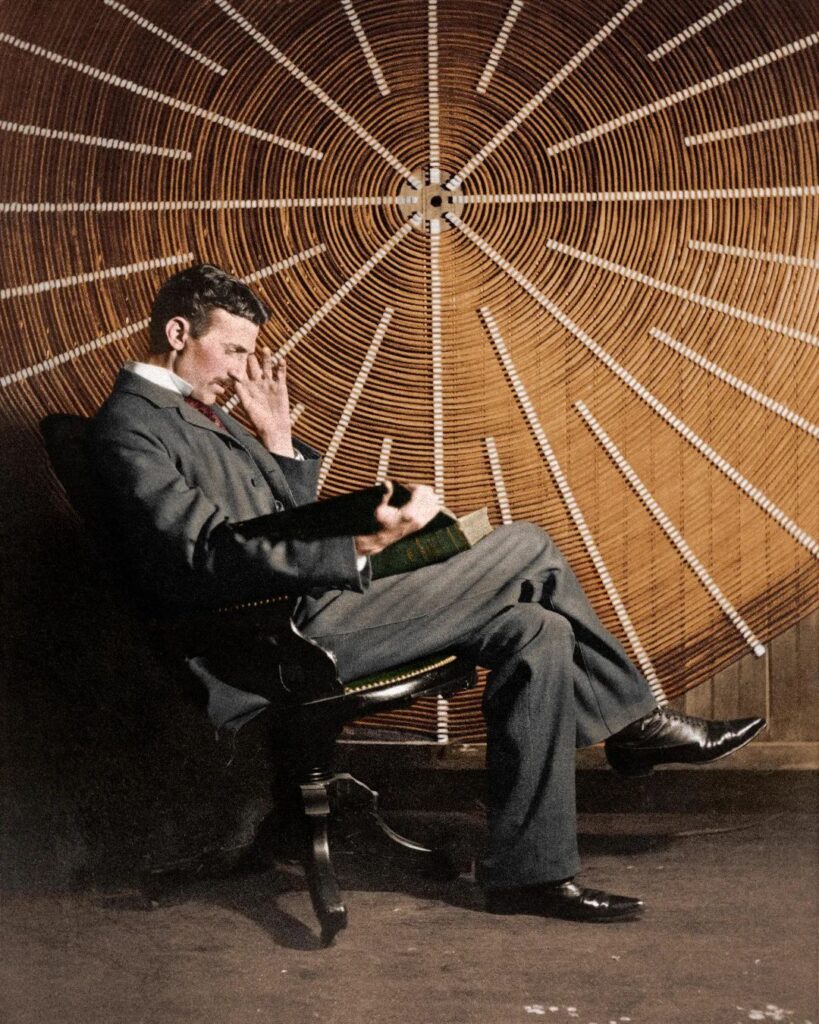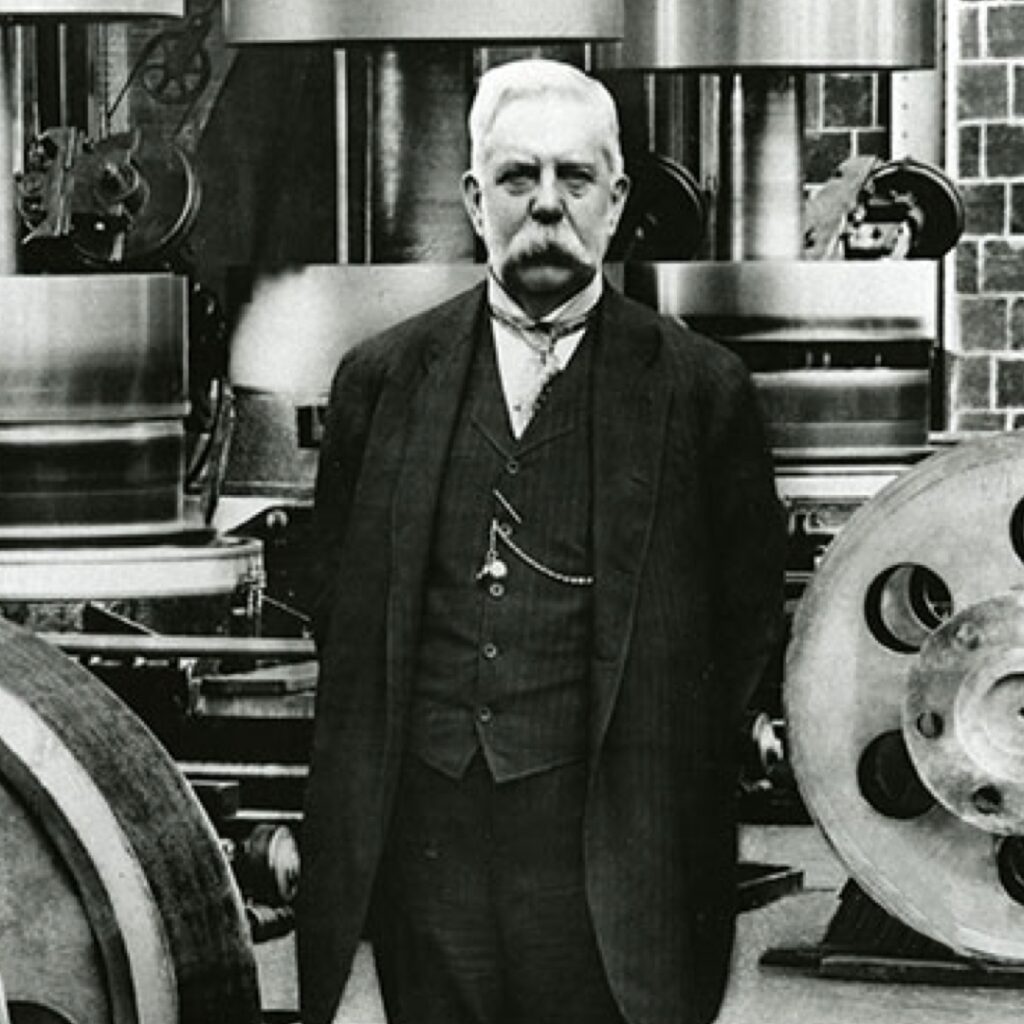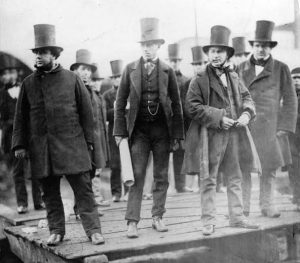In the closing years of the 19th century, America witnessed a current war—a clash of titans. Thomas Edison, Nikola Tesla, and George Westinghouse weren’t just pioneering inventors; they were the architects of today’s electrified world. The battle to electrify America between alternating current (AC) and direct current (DC) was more than a technological debate; it would shape the future of modern civilization.

Table of Contents
The Spark of Innovation: Setting the Stage

Thomas Edison, already a household name with his invention of the light bulb, sought to illuminate the world using direct current. DC was his brainchild, but it had its limitations: it couldn’t travel far without losing power.
Enter Nikola Tesla, a visionary inventor, with his revolutionary concept of alternating current. Tesla’s AC could travel long distances over thinner wires, with lesser power losses—a clear advantage over Edison’s DC.
In the waning years of the 19th century, the landscape of human enterprise lay on the cusp of a radical transformation, the seeds of which had been sown in the fertile minds of two titans of invention.
Thomas Edison, an inventor known as much for his relentless work ethic as for his prolific contribution to the field of science, had already etched his name into the annals of history with the glow of his incandescent bulb—a beacon that signified the dawn of a new era.

But if Edison’s bulb was the dawn, his Direct Current (DC) power system was the sun poised at high noon, ready to shine its light upon the world. DC was Edison’s vessel of enlightenment, a chariot upon which he envisaged the future cities of the world would ride, all awash in the electric glow of progress. Yet, like an ancient galleon, majestic but stubborn, DC faltered in the open sea of ambition; it could not traverse the long distances required to bind the sprawling cities and their hungry devices in a network of electric power.
As the limitations of DC became apparent, there was a stirring in the aether, a sense that the next great leap was imminent. Into this charged atmosphere stepped Nikola Tesla—a figure equally enigmatic and brilliant, an engineer with the soul of a poet and the mind of a visionary. His entry onto the stage was not merely a matter of one-upmanship against Edison; it was the natural unfurling of innovation’s relentless march.
Tesla saw what others did not. He perceived the electric current as a force that, like the rhythms of nature, could ebb and flow; it could alternate. Armed with this insight, Tesla conjured the alternating current (AC) system. It was nothing short of a revelation. AC was a current that changed direction periodically, and in this dynamism lay its strength. It meant that electricity could now be sent across vast distances on conduits no thicker than a common reed, without the great loss of power that plagued Edison’s Direct Current.
The stage for an epic confluence of wits and wills thus was set. On one side was Edison, entrenched, a colossus of industry with his direct current system—the very symbol of electric power up until that point. On the other stood Tesla, the maverick, clutching his diagrams for alternating current, the power of the future—a future that he could see clearly but had yet to manifest.
What followed was not merely a clash of inventions but a war of worlds; it was the struggle between the established and the innovative, between staying the course and daring to chart new ones. It was, as history would label it, the War of the Currents—a time when human ingenuity sparkled with a brilliance matched only by the electrical marvels it sought to create.
In that crucible of competition and creation, the spark of innovation was not merely the literal electricity but the insatiable quest for improvement. And while Tesla’s alternating current eventually outstripped Edison’s direct current in reach and efficiency, thus lighting the way forward, the true legacy of that era lay in the lesson it relayed: that the future is often illuminated not by the certainty of what is, but by the possibility of what could be.
Edison's Gambit: Power Plays and Fear Tactics
Not one to back down without a fight, Edison launched a smear campaign to discredit AC. His strategy was fearmongering, famously orchestrating public electrocutions of animals to show AC’s “dangers.” Edison believed that winning the current war was not just about technological superiority but also about public perception.
In the heated crescendo of the late 19th century’s Current War, Thomas Edison stood as a colossus amidst the crackling tension of technological rivalry. The air was electrified with innovation, but also with fear and propaganda. It was a time when the very sinews of the future were being forged and Edison, a titan of invention, was not about to be rendered obsolete by the rising tide of alternating current (AC).
The stage was set, and Edison’s fortitude was unyielding as he faced the complex challenge presented by the champions of AC, most notably Nikola Tesla and George Westinghouse. He had illuminated the world with his incandescent bulb and had an extensive investment in direct current (DC) infrastructure, but the AC system threatened to overturn his empire of light.
To counter this, Edison embraced a shadowy gambit. He wielded his influence and reputation like a conductor leading an orchestra, albeit this time it was a symphony of dread he was orchestrating. His campaign was not confined to championing the efficiency of DC but aimed to shroud AC in a pall of terror.
Edison’s chessboard was the public forum, and his pieces were fear tactics that he moved with strategic precision. He knew he needed a visceral display to turn public opinion against AC, and so he brokered in the currency of shock. The means were ghastly; the public electrocutions of animals. These spectacles were not just demonstrations of power but calculated performances aiming to ingrain a narrative of danger into the hearts of the onlooking masses.
A prominent instance was the sad fate of Topsy, a circus elephant. In a macabre show, Edison ensured her end would be by AC, purportedly to prove its lethal potential. The message was clear: if such a mighty beast could be felled by this invisible force, what hope could the common person have against it?
Such events were Edison’s psychological crusade, casting alternating current as a killer lurking in the walls of one’s home, sneering at the very concept of safety. These fear tactics were textbook Edison — he knew that the battle would not be won on the merits of science alone but that the court of public opinion held sway. It was a dark ruse, a play that gave no quarter, and sought to stoke the embers of fear until they grew into an inferno of opposition against AC.
Yet, even as he maneuvered with cunning and scaremongering, the tide was turning. The efficiency and practicality of AC, which allowed for electricity to be transmitted over long distances more easily than DC, slowly but inexorably won the favor of both industry and the public.
In this tale of progress, Edison stands as a tragic hero, flawed and fierce. His gambit—driven by a mixture of fear of change, personal pride, and financial interests—ultimately failed to stop the march of innovation. The war of currents ended not with the bang of a feared menace but with the silent hum of AC power stations lighting up the world, turning away from Edison’s prophecies of doom and towards an electrified future.
And so, the lore of Edison’s desperate gambit remains, a cautionary tale of how the fear of obscurity and the resistance to inevitable change can eclipse even the most brilliant of legacies. It is a narrative that hums with the currents of power plays and the crackles of fear tactics, a monument to the relentless pace of progress.
Tesla's Triumph: The Alternating Current Rises
In the twilight of the 19th century, a war of currents was raging. Cresting the horizon of this tumultuous battlefield was a man whose name would become synonymous with invention and electricity: Nikola Tesla. Against him stood the stalwart inventor Thomas Edison, a titan of direct current (DC). But Tesla, a visionary engineer, harbored a secret weapon: alternating current (AC).
Tesla’s foray into the current wars was not a solitary crusade. An equally pivotal character in this electrical odyssey was George Westinghouse, an entrepreneur with a keen eye for revolutionary technologies. When Westinghouse approached Tesla after his departure from Edison’s company, an alliance was formed that would alter the course of history.

The two men knew that to demonstrate the superiority of AC over Edison’s DC, they needed a stage grander than any before – the World’s Columbian Exposition in Chicago, 1893. This fair was to be a marvel of the modern age, a celebration of the 400 years since Columbus’s historic voyage, and now, it was to be the proving ground for Tesla’s alternating current.
As the Exposition approached, the grounds were awash with eager anticipation. The battle lines between AC and DC had been drawn in the public eye, fueled by Edison’s vigorous campaign to discredit AC as dangerous. But Tesla and Westinghouse remained undeterred, focusing on the illuminating task ahead.
When the fair opened its gates, what greeted visitors was nothing short of miraculous. An otherworldly glow bathed the White City, as Tesla’s alternating current powered more than 200,000 incandescent lamps. The glow was soft, the hum of electricity almost musical; it was a symphony of light such as the world had never seen. The Fair, touched by Tesla’s electrical wizardry, shone like a beacon of progress.
Skeptics were transformed into believers, awestruck by the dazzling display. In the glow of Tesla’s success, the murky fears cast by Edison about the dangers of AC power dissolved into the illuminated night. Tesla’s alternating current wasn’t just an abstract scientific concept; here, it was visceral, enchanting, alive – it was a triumph.
But Tesla, restless in victory, harbored grander designs. His next endeavor was to harness the raw power of nature itself: Niagara Falls. With rallying support from Westinghouse and the acclaim from the Exposition, Tesla’s AC system was chosen to transport energy from the falls to Buffalo, New York. Work commenced, and the world watched with bated breath as Tesla’s turbines and generators were installed at the legendary waterfall.
The completion of the Niagara Falls power project was nothing less than monumental. When AC power finally journeyed from the roaring cascades to light up Buffalo, it was a display of practicality on a colossal scale, a resounding affirmation of Tesla’s dream. This was electricity unfettered, not confined to the lab, but stretching across landscapes, binding cities, industries, and lives with unseen sinews of power.
The roar of Niagara’s waters was now a harmonious chorus with the alternating current’s pulse, a testament to Tesla’s genius and his and Westinghouse’s courage to challenge the currents of the time. The arc of history bent in gleaming conduits, and the world as it was known was irrevocably alight with Tesla’s triumph. The alternating current had indeed risen, not as a mere contender in the battle of currents, but as the clear victor that would power the new century and beyond.
The Tipping Point: AC's Ultimate Victory
The deciding battle came with the bid to power the United States using one of the systems. Westinghouse, armed with Tesla’s patents, won the contract to build a power station at Niagara Falls. AC’s ability to distribute electricity over great distances was undeniable now. Once the Niagara Falls project succeeded, the war was effectively over.
The AC’s Ultimate Victory arose when the United States teetered on the brink of a decision that would electrify its future. Two giants in electricity generation vied for the illustrious contract to illuminate and power a nation: to build a power station at the majestic Niagara Falls. On one side stood the established Edison Electric, and on the other, Westinghouse Electric, a company betting its future on Tesla’s patents.
Westinghouse, with Tesla as its luminary guide, emerged triumphant, winning the monumental contract. They embarked on constructing what would be the archetype of modern power stations. Tesla’s alternating current system was put to the ultimate test, tasked with taming the ferocious energy of Niagara Falls.
As the turbines began to turn and AC began its journey from the raging waters to the homes and cities far beyond, something miraculous unfolded. Electricity, once confined to a minimal radius around power stations due to the limitations of DC, now reached out across counties and states. The very landscape of human settlement transformed, as AC’s currents flowed across vast distances, bringing electric light and power to the remotest of areas.
The Niagara Falls project was more than an engineering triumph; it was the bellwether of a new era. With its resounding success, the War of the Currents reached its denouement. The once formidable gravitas of Edison’s DC could not compete with the evident practicality and scalability of Tesla and Westinghouse’s AC.
Nations took note, and one by one, they adopted the alternating current standard. It was this realization of AC’s potential that not only marked its ultimate victory over DC but also set the stage for the electrification of the entire world. With the power of Niagara harnessed, AC’s dominance was not just proven but etched into the chronicles of history, a feat that would illuminate the path of technological progress for centuries to come.
Thus, through great ingenuity and the courage to bet on the visionary designs of Tesla, Westinghouse not only won a contract but also charted the destiny of electrical power distribution. The world had indeed reached a tipping point, and the currents of change were irreversible. The victory at Niagara was not solely that of a company or a current, but of humanity’s unyielding search for a brighter, more electrified tomorrow.
Aftermath: Legacy and Integration
As the embers of the ‘War of the Currents’ cooled, Thomas Edison’s direct current (DC) did not fade into the abyss of forgotten inventions. Instead, like remnants of an old empire, fragments of his system persisted in the nooks and crannies of a world rushing toward an alternating current (AC) future.
Though Tesla’s AC had proven superior for long-distance power transmission, the versatility of DC began to find refuge in burgeoning domains. Ensconced within the very fabric of modern life are the whispers of Edison’s genius; DC current resigns itself to power the lifeblood of our technology.
Imagine a world without the convenience of portable power. In a reality stitched with battery-powered threads—from smartphones to laptops and from automobiles to aerial drones—belongs the legacy of DC. Each battery you charge, each press of the camera’s shutter, echoes back to Edison’s unyielded principles. Within solar power, where sunlight is converted directly into electricity, DC rules unopposed, an elemental force harnessed directly from the cosmos.
As society lunged forward, it inadvertently knotted the threads of Tesla’s AC with those of Edison’s DC. In modern power supplies, alternating current is often transformed to direct current to provide the stable voltages needed for delicate electronics. The power that charges your device may journey across miles as Tesla’s AC, only to be transmuted by a tiny rectifier into Edison’s DC before greeting your gadget’s circuits.
In this coexistence lies a tale of reconciliation, where innovation does not obliterate the old but rather assimilates and repurposes it. Tesla and Westinghouse had the foresight of the big picture, the grand design where power could leap across vast distances and light up cities as effortlessly as the stars light up the night sky. And yet, within the vast lattice of power lines and the hum of electricity lies a symphony—a duet of AC and DC currents.
The integration of these systems underscores a historical truth: progress in technology is rarely a zero-sum game. It is an intricate dance of advancement and transformation, where yesterday’s rivalries give birth to today’s alliances. The legacy of Edison and Tesla, once defined by their opposition, now converge in quiet harmony, energizing the multitude of devices that define our daily existence.
And so, the legacy of Edison’s DC didn’t die; it simply transformed, integrating itself into the DNA of technological progress, perpetually reminding us that the currents of history are as alternating as the system Tesla championed. With each passing day, as we unconsciously tap into the legacies of these giants, we live out an enduring testament to their era-defining clash and the eventual symbiosis of two electrifying dreams.
The Current War's Enduring Lessons
The battle between Edison, Tesla, and Westinghouse teaches us the power of innovation, persistence, and strategic partnerships. It also reminds us that the future favors not just those who hold great ideas but also those who can convince others of their vision’s value.
It’s an electrifying tale of ambition, controversy, and genius that continues to fuel conversations and technology development well into the 21st century. As we consider the battle of AC vs. DC, we realize that this wasn’t just a war to electrify America—it was a crusade that sparked the global electrification shaping humanity’s progress.
FAQ – AC vs. DC: Illuminating the Electrifying Battle of Edison, Tesla, and Westinghouse
The War of the Currents was a late 19th-century battle over electrical standards between Thomas Edison, who supported direct current (DC), and Nikola Tesla and George Westinghouse, who advocated for alternating current (AC).
Edison favored DC because his company had heavily invested in DC systems, believing them to be safer and more reliable than AC technologies at that time.
Tesla and Westinghouse argued that AC was more efficient over long distances due to its ability to easily transform voltages using transformers, reducing power loss.
At the Exposition, Westinghouse and Tesla’s AC system powered the fair’s thousands of lights, proving its safety and efficiency, and marking a turning point in public perception.
The successful transmission of AC power from Niagara Falls to Buffalo by Tesla and Westinghouse demonstrated AC’s capabilities on a large scale and led to widespread adoption.
Edison was known to have conducted public demonstrations of electrocuting animals using AC to depict it as a dangerous system, which has been viewed as unethical by many historians.
While AC powers most homes and businesses, DC is predominantly used in battery-powered electronics, cars, and for data storage, such as in solar power systems.
Although both currents are used today, AC became the dominant system for power transmission, effectively marking Tesla and Westinghouse as the victors for utility-scale power distribution.
The War of the Currents teaches us about the commercialization of technology, the consequences of corporate competition, and the impact of technological innovations on society.
Yes, modern power systems and devices often incorporate both AC and DC, capitalizing on the strengths of each. Converters and inverters are ubiquitous, allowing seamless conversion between AC and DC as needed.




























